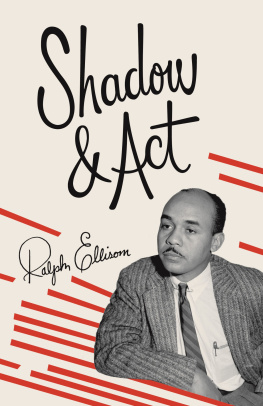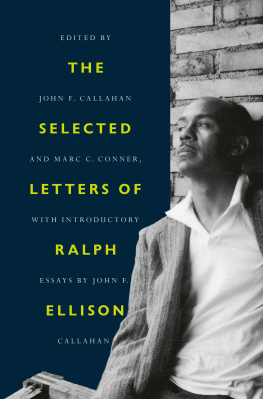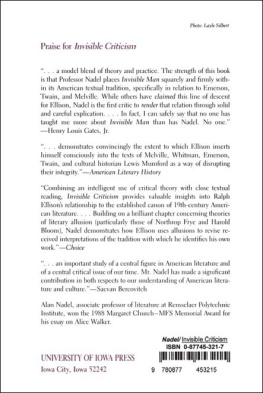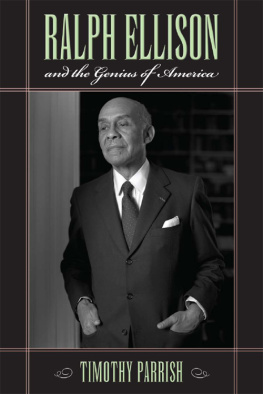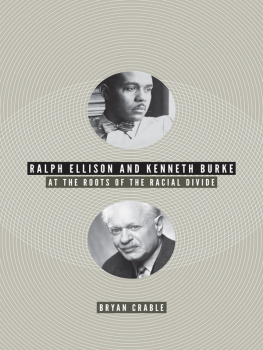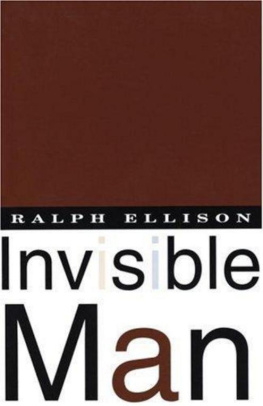Ralph Ellison in Progress
Ralph Ellison
in Progress
From Invisible Man to
Three Days Before the Shooting
ADAM BRADLEY
Yale
UNIVERSITY
PRESS
New Haven and London
Published with assistance from the foundation established in memory of Philip Hamilton McMillan of the Class of 1894, Yale College.
Copyright 2010 by Adam Bradley.
All texts by Ralph Ellison The Ralph and Fanny Ellison
Charitable Trust.
All rights reserved.
This book may not be reproduced, in whole or in part,
including illustrations, in any form (beyond that copying
permitted by Sections 107 and 108 of the U.S. Copyright Law
and except by reviewers for the public press), without written
permission from the publishers.
Set in Minion type by Integrated Publishing Solutions,
Grand Rapids, Michigan.
Printed in the United States of America by Maple-Vail.
Library of Congress Cataloging-in-Publication Data
Bradley, Adam.
Ralph Ellison in progress : from Invisible man to Three days before
the shooting / Adam Bradley.
p. cm.
Includes bibliographical references and index.
ISBN 978-0-300-14713-1 (alk. paper)
1. Ellison, RalphTechnique. 2. Ellison, RalphManuscripts.
3. Ellison, Ralph. Invisible man. 4. Ellison, Ralph. Three days
before the shooting I. Title.
PS3555.L625Z57 2010
813.54dc22 2009036607
A catalogue record for this book is available from
the British Library.
This paper meets the requirements of ANSI/NISO Z39.481992
(Permanence of Paper).
10 9 8 7 6 5 4 3 2 1
To John F. Callahan
On the Higher Frequencies
Contents
Introduction
1993
R alph Ellisons untitled second novel endsor rather, it stopswhen its protagonist, Alonzo Zuber Hickman, takes a quick look at the glowing 369 on the fanlight as he hurries away from the startling scene he has just witnessed at an old townhouse somewhere in the nations capital. Saved to his computer in December 1993, just months before his death in April 1994, these are among the final words of fiction Ellison would write.
As far as last words go, they seem like something of a disappointment. After all, they do not complete the novel Ellison had been laboring on for more than forty years. They do not sum up his life in letters; they offer no tidy epitaph. Yet for those initiated into Ellisons literary fellowship, they provide a fitting, if profane, bookend to his career as a novelist.
The secret lies in the number. Three-six-nine. Youll recall from Invisible Mans prologue that Ellisons unnamed protagonist illuminates his underground hideaway with a vast number of lightbulbs. In my hole in the basement, he gleefully explains, there are exactly 1,369 lights. Ive wired the entire ceiling, every inch of it. This inscrutable detail has perplexed readers since the novels publication in 1952, at least those curious enough to linger over Ellisons unusual numeric specificity. Perhaps the numbers held a coded meaning. Perhaps, some suggested, he chose 1,369 because its square root is thirty-seven, Ellisons age when he published Invisible Man. Ellison remained coy on the matter.
An alternate interpretation of the digits can be found among the numbers runners and payday gamblers in Ellisons Harlem. The numbers racket, also known as policy, was an off-the-books lottery where players would select a number, usually three digits long, in advance of a drawing. Claude McKay, writing in the mid-1930s, just before Ellison arrived in Harlem, notes the wild popularity of policy. As the game gripped the imagination of the Harlem masses, he recalls, the business of numbers magic flourished. Negroes became canny about numbers. Any number seen, or which came to ones mind under unusual circumstances, would be played. Few numbers were as infamous for policy players as three-six-nine, a numeric combination with its roots in Southern hoodoo. Blues lyrics, like these from Blind Arthur Blakes Policy Blues from 1930, warn against the numbers potency:
I acted the fool and played on 3, 6, 9
I act the fool and played on 3, 6, 9
Lost my money and that gal of mine.
Often players would draw their numbers from dreams, and the means of translating dreams into digits was a dream book, those numerological tomes that match anything your subconscious can conjure with a number ready to wager. Invisible Man finds such a great constitutional dream book among the belongings of the evicted elderly couple in Harlem. Mary Rambo consults a dream book in one of the novels expurgated drafts. For anyone familiar with a Harlem dream book, the meaning of Ellisons number would have been clear. Just as six-nine-four stands for rabbit and four-three-five stands for raccoon, three-six-nine stands for excrement.
That Ellison places this numerical inside joke both at the beginning of Invisible Man and at the end of the second novel offers an unexpected symmetry, a small gesture toward a greater truth. Ellisons fiction is united by this spirit of play, his unabashed embrace of folk idioms alongside the rarified literary culture he worked hard to claim. The reappearance of that funky coded number at the end of Ellisons literary life suggests the value of a backward glance. Heeding Invisible Mans admonition, perhaps Ellison had come to believe that for his fiction the end is in the beginning and lies far ahead.
Although critics tend to look to the beginning of Ellisons lifehis childhood and adolescence, his formative artistic experiences, his passion for musicas a means of understanding his artistic maturity, this book offers something different: a backward glance at Ellisons fiction from the perspective of his final, unfinished novel. Reading both novels in the process of their becoming endows us, like Ellisons nameless protagonist from Invisible Man, with a slightly different sense of time. Sometimes youre ahead and sometimes behind, he explains. Instead of the swift and imperceptible flowing of time, you are aware of its nodes, those points where time stands still or from which it leaps ahead. And you slip into the breaks and look around. This book is structured on such nodes of time in Ellisons life and literature. Beginning in the 1990s with his last efforts to complete the second novel, it moves backward through critical moments of stasis and transformation, moments of standing still and leaping ahead.
Interpreting Invisible Man in the same way as the manuscripts of Ellisons second novel reveals them both as works in progress. Instead of definitively settling matters of plot, character, and perspectivea necessary task for the author when preparing a novel for publicationsuch a critical approach opens them back up, not with the idea of second-guessing the author, nor even of suggesting that the published novel might stand to gain by the addition of this expurgated material; rather, the purpose is to expose the discrete textual decisions and indecisions that escape our view when reading the published novel alone. The result is a living text whose protean forms underscore the necessary indeterminacy of the artistic process.
Ellisons numerous manuscript drafts and notes housed in the Library of Congress constitute an evolving record of his aesthetic vision. The provisional, often fleeting nature of these working drafts charges them with a force undiminished by time. Unlike a published novel, which is the product of its authors acts of formal limitation as well as creation, these manuscripts in progress retain a sense of unfettered possibility. In Ellisons drafts, Invisible Man can have a wife, or not; Sun-raider can die, or somehow live on; first-person narration can take the place of third-person, or both can coexist alongside each other without the necessity of resolution. Ellisons second novel gives us no choice but to confront such compositional complexity. The unfinished novel is defined in large part by the choices Ellison did not make, the discrepancies he left unresolved. To read




